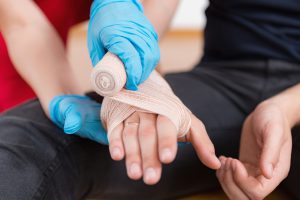In this post we’ll take a closer look at the role of the “appointed” first aider in the workplace. We’ll also explore some of the other responsibilities employers have towards their staff.

Employers First Aid Legal Responsibility
Employers have a legal responsibility to ensure their employees have access to adequate and appropriate first aid equipment, facilities, and people who know how to provide immediate on-site help in the even of illness or injury in the workplace.
You can read more about the Health and Safety (First Aid) laws.
To meet these requirements, most employers appoint dedicated first aiders in the workplace. These are usually existing members of staff who take on the role on a voluntary basis.
Who Can Be an Appointed First Aider?
Any member of staff can become an appointed first aider. But anyone who takes on the role must have adequate training. You need to take, at minimum, an emergency first aid training course. These courses usually last a day, and they’ll teach you the fundamentals of first aid in the workplace.
The Red Cross has a handy tool to help you find the right first aid course for your requirements. Head here to find a first aid course that works for you.
How Many First Aiders Does A Workplace Need?
When it comes to first aid in the workplace, employers have a legal responsibility to first carry out a First Aid Hazard Assessment. This will help you determine the first aid requirements in your workplace. Crucially, it will help you determine how many first aid kits you need, and how many first aiders you need to appoint.
Many workplaces should be able to get by with a single first aid kit and a single first aider to administer it. But obviously, bigger teams and bigger workplaces will need more. Larger businesses might consider appointing a first aider for each team, or each department, for example.
The First Aid Training Cooperative has an essential guide to First Aid Hazard Assessments on their website.
So What Are The Responsibilities of First Aiders in the Workplace?
First aiders are there to provide immediate medical care while you wait for further assistance. On one end of the scale, this could involve providing an employee with a plaster or a bandage after they cut their finger. But in other circumstances their support can be life-saving.
In some cases, a first aider can provide crucial assistance while you wait for an ambulance to arrive. And this really can mean the difference between life and death. Being a first aider in the workplace is no small responsibility.
Here are some examples of the sort of procedures a first aider may have to perform:
- Taking care of unconscious people – putting them in the recovery position to ensure their airway’s not blocked; ensuring that people undergoing fits don’t injure themselves.
- Performing cardiopulmonary resuscitation (CPR) – you’ll learn how to do this with a first aid dummy during your training.
- Using a defibrillator on someone undergoing cardiac arrest.
- Treating bleeding using pressure and elevation.
- Treating fractures through keeping limbs still and supported.
First aiders are there to preserve life. Chiefly, their responsibility is to ensure that things don’t get any worse before the emergency services arrive. But they’re also responsible for ensuring that any bystanders are safe, and to arrange for any further medical help as might be required – through calling 999, for instance.
First aiders can also provide a handover once the medical services arrive. They can make a note of any injuries and monitor any symptoms, so that the emergency services are better placed to act effectively once they’re onsite. Finally, first aiders can carry out any workplace paperwork following the incident – such as an accident report that could help prevent any further injuries.
What Other First Aid Responsibilities Do Employers Have?
One major responsibility is to ensure that all first aid kits in the workplace are adequately stocked. Employers should replace anything that needs replacing following an incident – such as plasters and bandages. They should also replace anything that expires, such as sealed sterile materials.
The Health and Safety Executive advises that all first aid kits should contain the following:
- A leaflet containing general first aid guidance.
- Individually-wrapped sterile plasters in a range of sizes.
- Individually-wrapped triangular bandages – ideally sterile.
- Sterile eye pads.
- Safety pins.
- Individually-wrapped unmedicated wound dressings in large and medium sizes.
- Disposable gloves.
You can read a full guide to your workplace first aid requirements.
Finally, employers have a legal responsibility to get employers liability insurance. This ensures that, if any employees do get ill or injured in the workplace, then they’ll be covered for all injuries. You should also get public liability insurance, which will cover you for accidents involving clients or members of the public.
At Tapoly we offer comprehensive business insurance at an affordable price. Head here to get a free quote in minutes.
If you have any questions, or you’d like to discuss your options, you can contact the Tapoly team at info@tapoly.com, call our info line on +44(0)207 846 0180, or use the chat box on our website.

